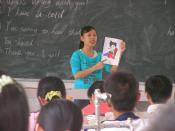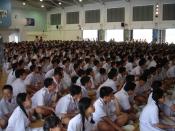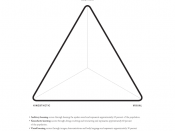Literature ReviewIntroductionThe researcher, in this chapter, will interpret and present materials of other researchers that surround the topic. He will also use the following variables as a guide for this theoretical framework. Independent Variable: Think-Pair-Share and Jig Saw and the Dependent Variable: Academic Performance.
Collaborative Learning is an educational approach to teaching and learning that involves groups of students working together to solve a problem, complete a task, or create a product. Collaborative Learning is based on the idea that learning is a naturally social act in which the participants talk among themselves, Gerlach (2004). It is through the talk that learning occurs.
There are many approaches to collaborative learning. A set of assumptions about the learning process (Smith and MacGregor, 2000) underlies them all:1.Learning is an active process whereby students assimilate the information and relate this new knowledge to a framework of prior knowledge.
2. Learning requires a challenge that opens the door for the learner to actively engage his/her peers, and to process and synthesize information rather than simply memorize and regurgitate it.
3.Learners benefit when exposed to diverse viewpoints from people with varied backgrounds.
4.Learning flourishes in a social environment where conversation between learners takes place. During this intellectual gymnastics, the learner creates a framework and meaning to the discourse.
5.In the Collaborative Learning environment, the learners are challenged both socially and emotionally as they listen to different perspectives, and are required to articulate and defend their ideas. In so doing, the learners begin to create their own unique conceptual frameworks and not rely solely on an expert's or a text's framework.
Thus, in a Collaborative Learning setting, learners have the opportunity to converse with peers, present and defend ideas, exchange diverse beliefs, question other conceptual frameworks, and be actively engaged.
Think-Pair-ShareThink-Pair-Share is a strategy designed to provide students with food for thought on a given topic enabling them to formulate individual ideas and share these ideas with another student, Hyman (2003). It is a learning strategy developed by Lyman and associates to encourage student classroom participation. Rather than using a basic recitation method in which a teacher poses a question and one student offers a response, Think-Pair-Share encourages a high degree of pupil response and can help keep students on task.
Cramer (2000), suggests that the purpose of Collaborative Learning should be taken into consideration when the strategies are being applied. Some of the purposes he cited include:â¢Providing think time increases quality of student responses.
â¢Students become actively involved in thinking about the concepts presented in the lesson.
â¢Research tells us that we need time to mentally chew over new ideas in order to store them in memory. When teachers present too much information all at once, much of that information is lost. If we give students time to think-pair-share throughout the lesson, more of the critical information is retained.
â¢When students talk over new ideas, they are forced to make sense of those new ideas in terms of their prior knowledge. Their misunderstandings about the topic are often revealed (and resolved) during this discussion stage.
â¢Students are more willing to participate since they don't feel the peer pressure involved in responding in front of the whole class.
â¢Think-Pair-Share is easy to use on the spur of the moment.
â¢Easy to use in large classes.
In think-pair-share, the teacher poses a challenging or open-ended question and gives students a half to one minute to think about the question (Cohen 2003). This is important because it gives students a chance to start to formulate answers by retrieving information from long-term memory. Students then pair with a collaborative group member or neighbour sitting nearby and discuss their ideas about the question for several minutes. The teacher may wish to always have students pair with a non-collaborative group member to expose them to more learning styles. The think-pair-share structure gives all students the opportunity to discuss their ideas. This is important because students start to construct their knowledge in these discussions and also to find out what they do and do not know. This active process is not normally available to them during traditional lectures, Freeman (2005).
After several minutes the teacher solicits students' comments or takes a classroom vote. Students are much more willing to respond after they have had a chance to discuss their ideas with a classmate because if the answer is wrong, the embarrassment is shared. The responses received are often more intellectually concise since students have had a chance to reflect on their ideas. The think-pair-share structure also enhances the students' oral communication skills as they discuss their ideas with the one another. This short intermission can also provide the teacher a timely opportunity to mentally go over the next concept to be discussed, Gross (2001).
One variation of this structure is to skip the whole-class discussion. Another variation is to have students write down their thoughts on note cards and collect them. This gives the teacher an opportunity to see whether there are problems in comprehension.
According to Kagan (1999), Educators fool themselves if they think well-meaning directives to work together, cooperate, and be a team, will be enough to create collaborative efforts among group members. Placing students in groups and telling them to work together does not in and of itself result in collaboration. Several educators concur that the following strategies must be observed for the effective use of the Think-Pair-Share.
Miller (2001), states that the teacher should assign, change partners and be sure to assign discussion partners rather than just saying turn to a partner and talk it over. When you don't assign partners, students frequently turn to the most popular student and leave the other person out. Switch the discussion partners frequently. With students seated in teams, they can pair with the person beside them for one discussion and the person across from them for the next discussion.
Wilkes (2004), opines that the teacher is to give think time, monitor discussions and randomly select students. He or she should provide adequate think time and may have students give a 'thumbs-up' sign when they have something they are ready to share. Walk around and monitor the discussion stage. The teacher will frequently hear misunderstandings that he or she can address during the whole-group discussion that follows. During the sharing stage at the end, call on students randomly. The teacher can do this by having a jar of popsicle sticks that have student names or numbers on them. One number for each student in the class, according to their number on your register. Draw out a popsicle stick and ask that person to tell what their partner said. The first time you do this; expect them to be quite shocked! Most children don't listen well, and all they know is what they said. If you keep using this strategy, they will learn to listen to their partner.
Smith (2001), concurs that Think-Pair-Share can be used for a single question or a series of questions. You might use it one time at the beginning of class to say, What do you know about ________ ? or at the end of class to say, What have you learned today?The question is 'How can I adapt to Collaborative Learning?' The following are typical simple strategies that one may use when utilizing the Collaborative Learning strategy.
Think-Write-Pair-Share - To increase individual accountability, have students jot down their ideas before turning to a partner to discuss them. You can walk around the room and look at what they are writing to see who understands the concept. It also keeps students from adopting the attitude that they will just sit back and let their partner do all the thinking, Tompkins (2001).
Science - Making predictions about an experiment, discussing the results of an experiment, talking over charts and graphs, drawing conclusions, developing a concept through discussion, talking about environmental problems, Suthers (2000).
Health - Discussing healthy practices, talking about how to handle stress, discussing proper placement of foods in food groups, analyzing problems in a diet, reviewing body systems, Dorneich (2000).
Social Studies - Discussing political viewpoints, learning about latitude and longitude, discussing economic trends, analyzing causes and effects of important events, discussing important contributions of historical figures, Rovai (2001).
Math Problem-Solving - Place a complex problem on the overhead. Ask students to think about the steps they would use to solve the problem, but do not let them figure out the actual answer. Without telling the answer to the problem, have students discuss their strategies for solving the problem. Then let them work out the problem individually and compare answers, Chang (2001).
Math - Practicing how to read large numbers, learning how to round numbers to various places, reviewing place value, solving word problem, recalling basic geometric terms, discussing the steps of division, discussing how to rename a fraction to lowest terms, Smith (2000).
Spelling - Call out a word, have them think of the spelling, then designate one person to turn and whisper the spelling to their partner. The partner gives a thumbs-up to show agreement, or corrects the spelling. You can reveal the correct spelling by uncovering the word from a chart, McKeachie (2004).
Reading - Discuss character traits and motives, make predictions before a chapter or at the end of a read-aloud session, discuss the theme of a book or story, make guesses about vocabulary words based on context clues in the story, discuss the meaning of similes and metaphors in a story, Solomon (1999).
Language Arts - Discuss Daily Oral Language responses, discuss ways to edit or revise a piece of writing, talk over story ideas, discuss letter-writing conventions, Melhuish (2001).
Art - Discuss elements of artistic compositions, discuss symbolism in artwork, compare and contrast the various works of a particular artist, analyze the use of color and line in works of art, Neuman (2001).
Music - Identify elements of musical compositions, identify instruments in musical selections, compare and contrast types of music, Miller (2001).
Students' BenefitsHarvey (2006) states with Think-Pair-Share, students are given time to think through their own answers to the question(s) before the questions are answered by other peers and the discussion moves on. Students also have the opportunity to think aloud with another student about their responses before being asked to share their ideas publicly. This strategy provides an opportunity for all students to share their thinking with at least one other student; this, in turn, increases their sense of involvement in classroom learning.
As a Collaborative Learning strategy, Think-Pair-Share also benefits students in the areas of peer acceptance, peer support, academic achievement, self-esteem, and increased interest in other students and school, McKeachie (2004).
Jigsaw Collaborative GroupsJigsaw groups foster understanding among students from a variety of racial, ethnic, and educational backgrounds. This learning method enables teachers to effectively respond to a diverse student population by promoting academic performance and cross-cultural understanding. Jigsaw groups facilitate learning because each student is responsible for a particular piece of a task and then is responsible to contribute his/her portion of the task to bring about mutual interdependence, (Freeman 2005).
The Set UpMcKeachie (2000), states that to create five groups of four students, have each student sit in his/her regular seat and number off each student one through five. Next, call all students that were given the number one to sit at a table together, then the twos, threes, etc. The groups should be diverse in terms of gender, ethnicity, race, and ability.
Student and Group RolesDivide the task into four segments. For example, in a project about the Slavery and Colonization, you may divide the lesson into the following topics: 1) Mother Colonies, 2) Where did the slaves originate? 3) Who were the slave masters? and 4) What was life like for the salves on the plantation?Assign each student in each group one of the four segments. Students who are assigned the same segment may meet to form an 'expert group.' The members of each expert group work together to learn the topic, making sure each member understands the information. During this time, the experts construct a plan to teach their topic to the members of their jigsaw collaborative group, McInnerney (2005).
Final OutcomeStudents then return to their jigsaw Collaborative group. Each student teaches his or her topic to the members of the group. There is a sense of positive interdependence among the members of the groups. To demonstrate knowledge, each jigsaw group may present a summary of their understanding to the whole class (Michaelsen, 2006).
Benefits of Heterogeneous GroupsEby (1994), Research shows that jig saw Collaborate groups, when students work together in heterogeneous groups, may improve race relations within a classroom. Working together within teams generates a more accepting and realistic view of other students than competitive and individualistic learning experiences.
Jigsaw Collaborative groups provide an equitable learning environment. When students of different ethnic, racial, and linguistic backgrounds work together, they develop respect for one another. In jigsaw groups, students are interdependent. Social acceptance of others increase because students need to help each other and learn from each other. Research shows that Collaborative Learning improves the social acceptance of mainstreamed students with learning disabilities, Slavin (1990).
Carvalho (2008), Students' academic performance is raised when all students work together towards a common goal. High achieving students learn tolerance and understanding of individual differences. Lower achieving students develop a greater understanding of subject matter. Students are highly motivated to work within a group. Teamwork helps students learn interpersonal skills, which is especially important in today's society.
Academic PerformanceLangley (2001), defines academic performance as the ability to study and remember facts, being able to study effectively and see how facts fit together and form larger patterns of knowledge. Academic performance also provides the ability to think for yourself in relation to facts and being able to communicate your knowledge verbally or put down on paper. Good academic performance is also linked to having good organizational skills such as a tidy place to work and good time management.
Warren (2002), states that academic performance, is a term that is usually referring to a general mental capability to reason, solve problems, think abstractly, learn and understand new material, and profit from past experience. Academic performance can be measured by many different kinds of tasks. Likewise, this ability is expressed in many aspects of a person's life. Academic performance draws on a variety of mental processes, including memory, learning, perception, decision-making, thinking, and reasoning.
Most people have an intuitive notion of what academic performance is, and many words in the English language distinguish between different levels of intellectual skill: bright, dull, smart, stupid, clever, slow, and so on. Yet according to Gardner, (2005) no universally accepted definition of academic performance exists, and people continue to debate what, exactly, it is. Is academic performance a property of the brain, a characteristic of behaviour, or a set of knowledge and skills? Gardner, (2005).
People in the general population have somewhat different conceptions of academic performance than do most experts. Laypersons and the popular press tend to emphasize cleverness, common sense, practical problem-solving ability, verbal ability, and interest in learning. In addition, many people think social competence is an important component of academic performance.
In recent years, a number of theorists have argued that standard academic performance tests measure only a portion of the human abilities that could be considered aspects of intelligence. Other scholars believe that such tests accurately measure academic performance.
Psychologist Lev Vygotsky (1992), supported the view that children's academic performance is not influenced through cognition only but their social world as well. Vygotsky posits that children learn through interaction with their peers. Collaborative Learning is a medium that helps to provide this type of interaction which influences academic performance.
BIBLIOGRAPHYBeaumont, D. (1997). Notes and Queries: G. Bell PublicationCollier, K. A. (2000). Collaborative Learning and the "conversation of mankind."College English, 46(7), 635-652.
Cramer, W. & Smith, K. Eds. (2000). New paradigms for college teaching. Edina,MN: InteractionCreswell, F. (2005). Complete Vocabulary: Oxford University PressEby, L. & Lunsford, A. (1994). Singular texts/plural authors: Perspectives oncollaborative writing. Carbondale, IL, Southern Illinois University Press.


